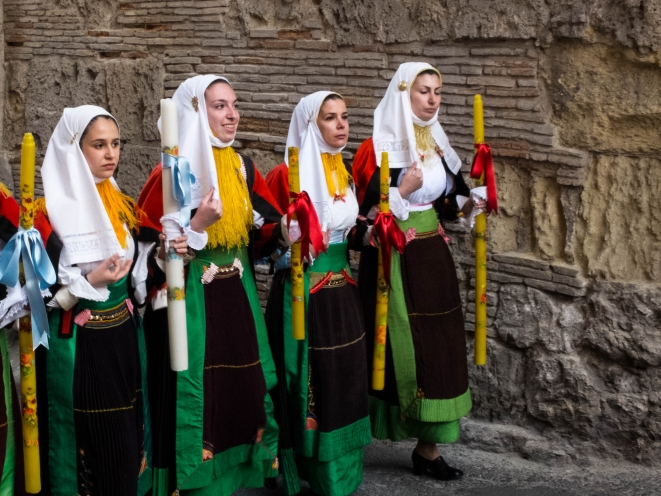Sant'Efisio, a beauty parade
The authenticity and the loving attention for details of the artisans of fashion in the Sardinia traditional dresses
Folk groups from all over the island on the feast of Saint Efisio prepare this important event with the excitement of those who are about to join the most beautiful ceremony, the most heartfelt religious liturgy that takes place for almost 400 years First May in Cagliari. Accompanied by the sound of launeddas and the typical songs, about 5500 people in traditional costume parade on a carpet of flower petals through the streets of the city center. Certainly an unusual catwalk for a parade of high fashion, but at Sant'Efisio, the public not only assists in the procession of the Holy Martyr patron of Cagliari and Sardinia. Indeed, do not get tired to admire and appreciate the sumptuous clothing worn by men, women and children, loads of jewelry, ribbons and bows on cloth by the bright colors, decorated with lace and embroidery "haut de gamme", that is of high quality, as they say without doubt in Paris.

As tradition dictates, the chariot of the Saint is accompanied not only by the notables, by the militia on horseback and from the greeting of the ships docking in the city harbor, a parade of folk groups in traditional Sardinian dress, visible in all the most various forms, depending on the different communities of origin. There are many villages in Sardinia, as are the variety of clothes. However, as there is not a unique model, representative of the entire region, you can highlight a few basic elements that compose it and make it unique.
For women, the head should be carefully covered or with a simple handkerchief, a scarf, a veil, or by more complex structures, with the addition of bandages, bonnet, mantles or even an "apron" of the head. Variants of colors, fabrics, techniques of knotting, embroidery and the use of brooches of gold or silver are countless and characteristics of the place of origin. For the bust, is ubiquitous white shirt of linen or cotton, embellished with lace and embroidered usually applied in visible parts: the neck, the chest, the cuffs. Above the shirt he is wearing a bodice and a jacket. Again, analyzing each case, it is often recognizable the hand of the craftsman who made the local item unique. But in all definitely we notice the use of rich fabrics, here embroidered with floral motifs, there with stylized motifs of fantastic animals embellished with beads or sequins. Finally, to complete the description of women's clothes, skirt and apron conclude the elegant shape and magnificent set of the festival.
The skirt is always long, entirely pleated, with the exception of the front panel covered by the apron, often adorned on the lower edge by colored and golden ribbons in floral patterns. In some cases, using bands in precious cloth wrapped around the waist to cover the edge of the skirt and apron strings.

Also in the male dress the headgear does not miss; the most common is the Phrygian cap hat, black or red, in cloth or in rough wool, about 60 cm long, which is worn behind the head making it fall on a shoulder or folded on itself. The shirt is white and large, sometimes with the collar, cuffs and chest embroidered. It may be closed at the neck with buttons or pins in gold or silver. The bodice, as the female, is of fine cloth. With or without sleeves, it is closed on the front with double or single breasted. It may have different colors, even if the black triumphs; often it is embroidered or has polychrome finishes on the front. Also the pants are always white and large, long mid-calf and tucked into gaiters, which cover the leg and hide part of the shoes. A garment very characteristic of male Sardinian is the skirt, a simple rectangle of cloth, gathered at the waist. A thin strip of fabric combines the front to the rear, passing under the crotch. The man, above the dress, wears different jackets or coats, depending on class and profession.
Children are dressed like adults; there is not a "fashion" suitable to them, as after all it was normal at the time of tradition, but certainly seeing a child with clothes so bright, full of laces and jewelry that resembles his father or his mother, but in tiny version, is cause for extra charm.
Hard to describe in words the beauty of these clothes and how they make it even more beautiful men and women who wear them with elegance and pride. Hard to look away from these handmade creations: every detail is a small masterpiece created with accuracy and pique. Difficult, finally, do not take away with them, in the eyes, mind and heart a little culture, tradition and soul of Sardinia when the largest procession of the island disappears on the horizon into the sunset on the sea of Nora. Devotion, faith, hope of many Sardinians is almost tangible in its deepest essence, as well as the love they have for their land.